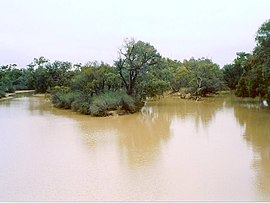Town in New South Wales, Australia
| Wanaaring New South Wales | |||||||||
|---|---|---|---|---|---|---|---|---|---|
 Paroo River at Wanaaring Paroo River at Wanaaring | |||||||||
 | |||||||||
| Coordinates | 29°42′18″S 144°05′24″E / 29.70500°S 144.09000°E / -29.70500; 144.09000 | ||||||||
| Population | 140 (2016 census) | ||||||||
| Postcode(s) | 2840 | ||||||||
| Elevation | 110 m (361 ft) | ||||||||
| LGA(s) | Bourke Shire | ||||||||
| State electorate(s) | Barwon | ||||||||
| Federal division(s) | Parkes | ||||||||
| |||||||||
Wanaaring is a remote outback village in north western New South Wales, Australia. Situated on the Paroo River, some 980 kilometres from Sydney, and 180 km west of Bourke. At the 2016 census, Wanaaring had a population of 140.
Wanaaring is on the "Cut Line" road between the town of Bourke, and the desert village of Tibooburra. Long distance travellers often stop at Wanaaring for meals or to refuel.
Wanaaring is in outback Australia, in remote agricultural country. The grazing lands support cattle, sheep and goats. Honey is also produced. An all-weather air strip is located east of the village centre.
Activities
Fishing and bush camping by the Paroo River. There is an annual gymkhana and rodeo, which supports the Royal Flying Doctor Service. The Flying Doctor provides essential medical aid to outback communities such as Wanaaring.
History
Wanaaring is in the traditional lands of the Paaruntyi people who called the area Moukilimoultha. Pastoralist Vincent James Dowling conducted the first European survey of the region in 1860. In January 1862, George Curlewis and his associate McCullough were killed by local Aboriginal men while looking to take up land near to what is now Wanaaring. Explorer and early Paroo River colonist Duncan McIntyre located and buried their remains in 1864 after interviewing other Paaruntyi. Some colonists hunted and shot down the Paaruntyi people, while others utilised them as shepherds on the newly established pastoral properties.
William Malpass established the Paroo Inn at Wanaaring in 1867.
Wanaaring is believed to be the local Aboriginal word for a wood duck.
Climate
The climate is semi-arid, featuring low rainfall, very hot summer temperatures and cool nights in winter. Wanaaring holds the Australian record for the highest minimum temperature, 36.6 °C recorded on 26 January 2019. A minimum temperature of -3.9 °C was recorded in July 1997.
| Wanaaring | ||||||||||||||||||||||||||||||||||||||||||||||||||||||||||||
|---|---|---|---|---|---|---|---|---|---|---|---|---|---|---|---|---|---|---|---|---|---|---|---|---|---|---|---|---|---|---|---|---|---|---|---|---|---|---|---|---|---|---|---|---|---|---|---|---|---|---|---|---|---|---|---|---|---|---|---|---|
| Climate chart (explanation) | ||||||||||||||||||||||||||||||||||||||||||||||||||||||||||||
| ||||||||||||||||||||||||||||||||||||||||||||||||||||||||||||
| ||||||||||||||||||||||||||||||||||||||||||||||||||||||||||||
| Climate data for Wanaaring Post Office (108m elevation) 1991–2020 | |||||||||||||
|---|---|---|---|---|---|---|---|---|---|---|---|---|---|
| Month | Jan | Feb | Mar | Apr | May | Jun | Jul | Aug | Sep | Oct | Nov | Dec | Year |
| Mean daily maximum °C (°F) | 37.3 (99.1) |
35.6 (96.1) |
32.7 (90.9) |
28.2 (82.8) |
22.8 (73.0) |
19.1 (66.4) |
19.0 (66.2) |
21.4 (70.5) |
25.7 (78.3) |
29.7 (85.5) |
32.9 (91.2) |
35.4 (95.7) |
28.3 (82.9) |
| Mean daily minimum °C (°F) | 22.4 (72.3) |
21.4 (70.5) |
17.9 (64.2) |
13.3 (55.9) |
8.4 (47.1) |
5.4 (41.7) |
4.1 (39.4) |
5.1 (41.2) |
9.0 (48.2) |
13.3 (55.9) |
17.2 (63.0) |
20.1 (68.2) |
13.1 (55.6) |
| Average rainfall mm (inches) | 38.5 (1.52) |
38.8 (1.53) |
20.0 (0.79) |
14.4 (0.57) |
24.1 (0.95) |
21.1 (0.83) |
19.5 (0.77) |
13.1 (0.52) |
20.8 (0.82) |
24.6 (0.97) |
32.1 (1.26) |
29.9 (1.18) |
296.6 (11.68) |
| Average rainy days | 4.7 | 3.9 | 3.6 | 2.1 | 4.4 | 5.4 | 4.7 | 3.0 | 3.6 | 4.3 | 5.0 | 4.2 | 48.9 |
| Source: bom.gov.au | |||||||||||||
References
- ^ Australian Bureau of Statistics (27 June 2017). "Wanaaring (State Suburb)". 2016 Census QuickStats. Retrieved 5 April 2015.

- ^ "Historical Society Notes". Western Herald. New South Wales, Australia. 14 June 1968. p. 5. Retrieved 14 June 2023 – via National Library of Australia.
- "Deniliquin". The Maitland Mercury and Hunter River General Advertiser. Vol. XIX, no. 2188. New South Wales, Australia. 29 May 1862. p. 2. Retrieved 14 June 2023 – via National Library of Australia.
- "The Darling". The Sydney Morning Herald. Vol. XLVI, no. 7570. New South Wales, Australia. 10 September 1862. p. 5. Retrieved 14 June 2023 – via National Library of Australia.
- "Explorations on the Paroo, Flinders, and Shores of Carpentaria". Mount Alexander Mail. No. 1813. Victoria, Australia. 4 January 1865. p. 3. Retrieved 14 June 2023 – via National Library of Australia.
- "News and Notes". The Ballarat Star. Vol. X, no. 199. Victoria, Australia. 22 August 1865. p. 2. Retrieved 14 June 2023 – via National Library of Australia.
- "Government Gazette Notices". New South Wales Government Gazette. No. 15. New South Wales, Australia. 22 January 1867. p. 205. Retrieved 14 June 2023 – via National Library of Australia.
- "A Flashback". Western Herald. New South Wales, Australia. 25 November 1966. p. 9. Retrieved 14 June 2023 – via National Library of Australia.
- "Daily Extremes". Retrieved 18 November 2023.
- "Climate statistics for Australian locations". Retrieved 18 November 2023.
- "Climate Normals 1991–2020". BOM. Retrieved 23 February 2021.
| Towns and Villages in Bourke Shire local government area | |
|---|---|
| Main Article: Local government areas of New South Wales |
This Far West geography article is a stub. You can help Misplaced Pages by expanding it. |